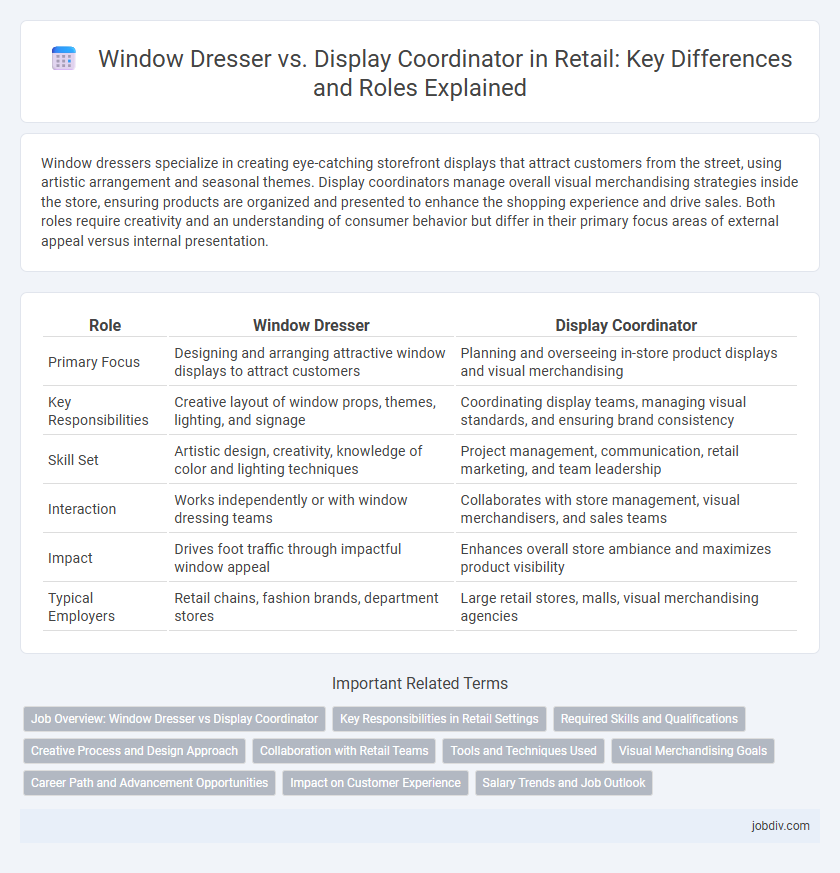Window dressers specialize in creating eye-catching storefront displays that attract customers from the street, using artistic arrangement and seasonal themes. Display coordinators manage overall visual merchandising strategies inside the store, ensuring products are organized and presented to enhance the shopping experience and drive sales. Both roles require creativity and an understanding of consumer behavior but differ in their primary focus areas of external appeal versus internal presentation.
Table of Comparison
| Role | Window Dresser | Display Coordinator |
|---|---|---|
| Primary Focus | Designing and arranging attractive window displays to attract customers | Planning and overseeing in-store product displays and visual merchandising |
| Key Responsibilities | Creative layout of window props, themes, lighting, and signage | Coordinating display teams, managing visual standards, and ensuring brand consistency |
| Skill Set | Artistic design, creativity, knowledge of color and lighting techniques | Project management, communication, retail marketing, and team leadership |
| Interaction | Works independently or with window dressing teams | Collaborates with store management, visual merchandisers, and sales teams |
| Impact | Drives foot traffic through impactful window appeal | Enhances overall store ambiance and maximizes product visibility |
| Typical Employers | Retail chains, fashion brands, department stores | Large retail stores, malls, visual merchandising agencies |
Job Overview: Window Dresser vs Display Coordinator
Window Dressers specialize in creating visually appealing storefronts by arranging products and decorative elements to attract customers and enhance brand identity. Display Coordinators manage the overall layout and presentation of merchandise within the store, ensuring cohesive visual merchandising strategies that maximize sales and customer engagement. Both roles require strong creativity and an eye for detail but differ in scope, with Window Dressers focusing primarily on exterior displays and Display Coordinators overseeing internal store aesthetics.
Key Responsibilities in Retail Settings
Window dressers specialize in designing and arranging eye-catching storefront displays to attract foot traffic, emphasizing visual appeal and seasonal themes. Display coordinators manage broader retail presentation, including in-store displays, signage placement, and merchandising strategies to enhance the overall customer shopping experience. Both roles collaborate to ensure cohesive brand representation and maximize product visibility in competitive retail environments.
Required Skills and Qualifications
Window Dressers excel in visual merchandising with strong skills in creativity, color theory, and spatial awareness, requiring a keen eye for detail and proficiency in design software. Display Coordinators demand advanced project management abilities, leadership experience, and effective communication skills to oversee team collaboration and ensure brand consistency across multiple retail locations. Both roles benefit from knowledge of consumer behavior, retail trends, and inventory management, but Display Coordinators typically hold qualifications in marketing or business administration, while Window Dressers often come from design or art backgrounds.
Creative Process and Design Approach
A Window Dresser focuses on creating visually appealing storefront displays that attract customers by emphasizing seasonal trends, color schemes, and spatial arrangement to enhance brand identity. A Display Coordinator develops comprehensive in-store merchandising strategies, balancing creative concepts with sales goals and customer flow to optimize product placement and overall shopping experience. Both roles require collaboration with marketing and visual teams, but the Window Dresser prioritizes artistic expression while the Display Coordinator integrates design with business objectives.
Collaboration with Retail Teams
Window Dressers collaborate closely with retail visual merchandisers and store managers to create eye-catching window displays that align with brand aesthetics and marketing campaigns. Display Coordinators work alongside sales teams and inventory managers to design and maintain in-store product presentations that enhance customer experience and drive sales. Both roles require strong communication and teamwork skills to ensure cohesive visual storytelling and seamless integration with retail operations.
Tools and Techniques Used
Window dressers primarily utilize visual merchandising tools such as mannequins, fabric drapes, lighting, and props to create captivating storefront displays that attract passersby. Display coordinators focus on layout design software, planograms, and inventory management systems to organize in-store product placement and ensure cohesive branding throughout the retail environment. Both roles integrate digital imaging and trend analysis tools to align displays with seasonal promotions and target customer demographics.
Visual Merchandising Goals
Window Dressers focus on creating captivating storefront displays to attract foot traffic and enhance brand visibility, emphasizing seasonal themes and product highlights. Display Coordinators manage the overall visual merchandising strategy within the store, ensuring cohesive product presentation and optimizing layout for shopper engagement and sales conversion. Both roles align with visual merchandising goals by driving customer interest and reinforcing brand identity through strategic aesthetic planning.
Career Path and Advancement Opportunities
Window Dressers often start their careers focusing on creative visual merchandising, developing skills in design, color theory, and retail trends to attract customers. Display Coordinators typically advance from window dressing roles by gaining experience in project management, team collaboration, and broader merchandising strategies, positioning themselves for leadership roles. Career advancement opportunities include senior visual merchandiser, retail design manager, or creative director, with higher responsibility for brand presentation and store aesthetics.
Impact on Customer Experience
Window dressers enhance customer experience by creating visually appealing and thematic storefronts that attract foot traffic and convey brand identity effectively. Display coordinators optimize in-store layout and product arrangement, facilitating easy navigation and promoting product discovery, which leads to increased customer satisfaction. Both roles collaborate to ensure a cohesive and immersive shopping environment that drives engagement and boosts sales.
Salary Trends and Job Outlook
Window Dressers typically earn between $30,000 and $45,000 annually, reflecting a demand linked closely to seasonal retail cycles and store promotions. Display Coordinators command higher salaries, ranging from $40,000 to $60,000, driven by increased responsibility in managing visual merchandising strategies and team coordination. The job outlook for Display Coordinators is more robust, with a 7% growth rate projected over the next decade due to expansion in e-commerce and experiential retail trends, while Window Dresser roles remain steady but face automation challenges.
Window Dresser vs Display Coordinator Infographic

 jobdiv.com
jobdiv.com